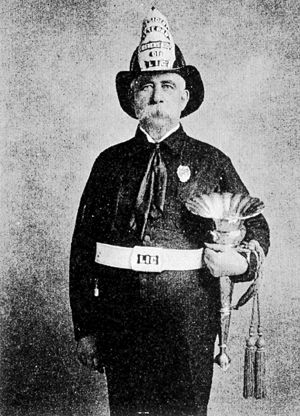 One of the lasting symbols of the modern American fire service is the use of bugles to signify one's rank as an officer. But where did it start and why? I always wondered this and luckily my current department has a rich history to draw from.
One of the lasting symbols of the modern American fire service is the use of bugles to signify one's rank as an officer. But where did it start and why? I always wondered this and luckily my current department has a rich history to draw from.Bugles, or speaking trumpets, were used on early fire grounds by the foreman of the hand pump teams to keep the large numbers of men working together to keep the pump working.
The foreman would often have to shout louder than other companies arriving, the fire and the crowds.

As hand pumps were replaced by steamers, the foreman became the leader of the fire fight and no longer dragged the bugle with him. The volunteer companies of the late 19th century and early 20th century used the bugles as a sign of their long history of service.
The bugle then became a kind of ornament at the fire halls, to be polished by prospective members and displayed proudly on parade day and in photographs. Similar to the ornate belts and helmet shields worn by the more experienced members.
But that explains why the bugle is used as a sign of rank, but why do we wear them on our collar instead of on our epaulets or our sleeves, as does the military?
 The answer is in our professionalism. Note this photo from Hose Company No 1 in Nebraska. Each member is wearing their dress uniform, which was common at the time. Each coat has one row of buttons. The officer, in the center seat, holds the bugle, signifying him as the leader.
The answer is in our professionalism. Note this photo from Hose Company No 1 in Nebraska. Each member is wearing their dress uniform, which was common at the time. Each coat has one row of buttons. The officer, in the center seat, holds the bugle, signifying him as the leader.Without the bugle, he is difficult to identify as the Officer of the company, yes?
As departments became consolidated and fell under the supervision of the local governments, there became a need to have additional ranks between the bugle of the Officer and the white helmet of the Chief Engineer or Volunteer President. Enter the double breasted coat. This coat had two rows of buttons, making the new Officers easy to spot and gave them more formality than the original company Officers. In most departments a single bugle signifies a lieutenant, or Company Officer. Two bugles signifies a Captain, or multi company Officer. The two bugles noted that he controlled more than one company, usually a hose and ladder team in the same house or hall.
Often, the collar of the coat would button down to the coat. This became the symbol of the lead Officer. Try as I might, I can't find a reference to who was the first to inscribe or order buttons with bugles for their coats, but the insignia appears in many photographs beginning in the late 1910s.

This photo from the LA Fire Department shows the two Captains on the right, double breasted coats, two rows of buttons and additional insignia on their collar.
As departments became more relaxed and dress coats were no longer worn, the insignia stayed on the uniform shirt. Right in the same place the original officers found proper to place it 100 years ago.
Now it sometimes appears on the collars of polo shirts. Sometimes I wish we would get back to the formality that existed in those days, but the last vomiting patient I had would have ruined my dress uniform. We change with the times I guess.
a note. This history is gathered from my experiences and photographs from my and other departments. Your department may have it's own traditions and history, but this is the story I keep hearing.


Comments
Great work. It's linked.
Thanks for the post.